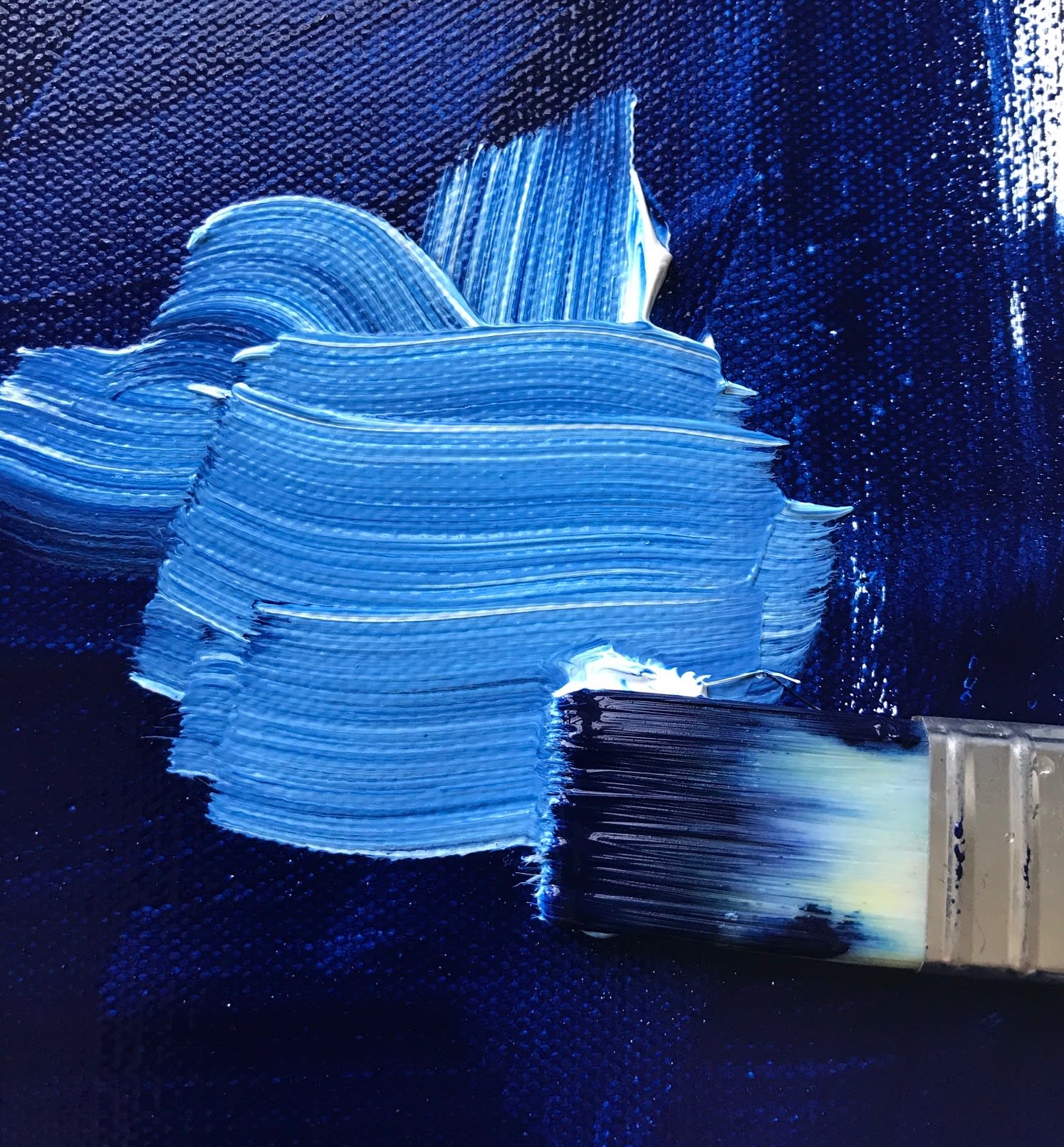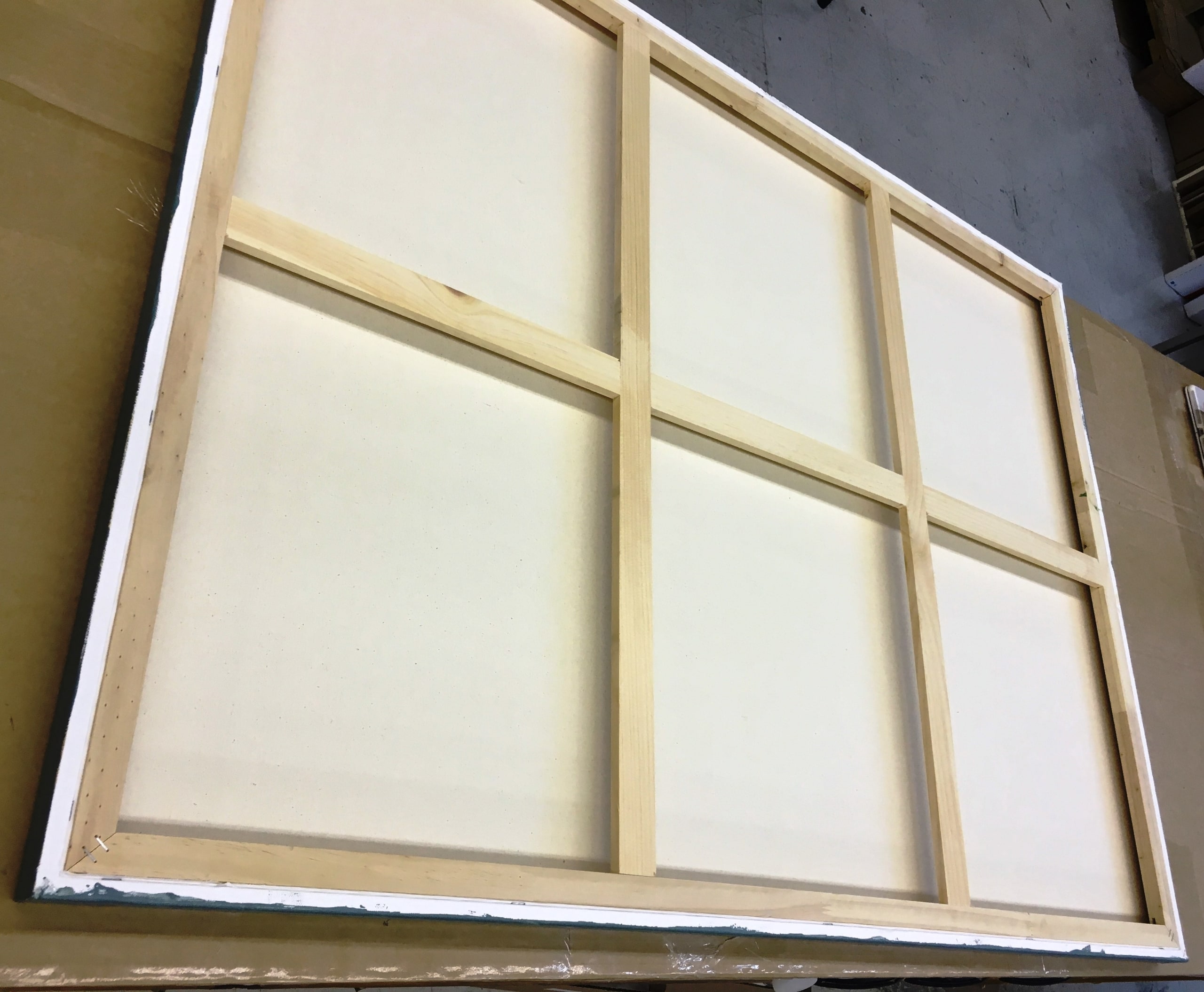How to Frame a Canvas Painting or Print
Most framing projects are simple, with a flat print that slides easily into one of our easy-to-assemble floating frames. With certain pieces of artwork, however, it may take extra components like wood filler, wood glue, custom framing and just a little bit more time.
In this DIY canvas framing guide, we'll show you step by step how to frame a painting, canvas art or prints and get that professional look for your one-of-a-kind piece.
Framing Canvas Prints and Paintings

Canvas is a type of woven fabric upon which artists can paint or, more recently, print with specialty printers. There are two ways to purchase them: stretched onto a wooden frame or rolled. Canvases on stretcher bars require another frame, either a standard wood or metal picture frame or even floater frames to finish the piece, while a rolled painting or print must first be stretched and placed into these wooden stretcher bars before they are framed.
How to Frame Canvases in 7 Steps
- Measure The Height and Width
- Place Canvas Face down on Clean Surface
- Fold the Canvas
- Turn Over and Repeat
- Pull the Canvas
- Fold the Corners
- Place in Final Frame
Materials You'll Need
Wood glue, nail gun, frame pieces, wood stain (optional if using your own DIY frame), hanger wire, tape measure and some patience.

Step 1: Measure The Height and Width
First, you’ll need to measure the height and width to see what frame size you’ll need. Make sure to leave enough canvas to fold and staple to the stretcher bar. If you need to cut the canvas because there is an excess that makes folding impossible or bulky, leave at least two inches to fold over and stretch.
TIP: Use shorter stretcher bars if you’d like to use a wood frame. If you’re using a floater frame, read our guide to pairing floater frames with stretcher bars to find the right size.
Step 2: Place Canvas Face down on Clean Surface
Place your canvas face down on a clean surface. To ensure that the canvas is placed evenly, measure the distance between the corners; they should be the same.
Step 3: Fold the Canvas
Starting on one of the shorter sides of the canvas, fold one side of the “extra” canvas over the stretcher bar and use the canvas pliers to hold it in place. If you’re not using canvas pliers, you can simply begin stapling. Staple once in the middle of the folded piece of canvas.
Step 4: Turn Over and Repeat
Turn the canvas to the opposite side (turning 180 degrees) and repeat the folding and stapling step until all sides are done.
Step 5: Pull the Canvas
Once each side of the frame have a single staple, pull the canvas slightly — not too much, or your canvas won’t be able to shrink or expand — and add a staple on either side of the middle one, spaced evenly apart.
Step 6: Fold the Corners
Fold the corners by tucking one side under the other, making sure that you are pulling tightly. Cut the tip of the corner before folding down and then staple it to the frame.
Step 7: Place in Final Frame
Once your canvas is stretched, you can place it into its final frame.

How to Frame Canvas Art That's Rolled
There are different reasons someone might purchase a rolled print (aka unstretched canvas) instead of one that’s already been stretched onto a frame. You may pay less money for a rolled canvas piece, or you may prefer to have the material stretched just prior to framing to ensure it doesn’t loosen. Other times, it’s the only option available.
If you’ve purchased a rolled canvas print or painting, you’ll need to stretch the canvas before framing it. Note that a rolled painting should actually be rolled with the paint on the outside, which may seem counterintuitive; however, this puts less stress on the paint and reduces the chances of cracking.
To frame a rolled print or piece of art, you’ll need a few extra items:
- Stretcher bar frame
- Staple or nail gun
- Canvas pliers (optional)
- Wood, metal or floater frame
- Glazing aka framing glass (optional)
Framing Stretched Canvas Prints and Paintings
When framing a canvas print that’s already been stretched onto stretcher bars, you’ll have less work to do — but you may need help choosing the right frame!
You can choose a wood picture frame, metal frame or floater frame for stretched canvas artwork, the latter of which is made especially for canvases. For all types of frames, it is important to make sure that the rabbet of the frame is larger than the thickness of the stretcher bar so that the artwork fits properly within it. A wood frame with a rabbet that is too small will force the artwork away from the wall; with a metal frame, you simply will not be able to slide the canvas inside.
Most pre-stretched canvases are one of three thicknesses: 5/8”, 3/4”, and 1 1/2'”. Frame Destination carries a number of wood and metal frames suitable for these standard sizes as well as corner braces, hanging wire and framed canvas bars.
| Wood Frames | 5/8" | 3/4" | 1 1/2" | 1 3/4" | 2" |
|---|---|---|---|---|---|
| 310 | X | X | |||
| 502 | X | X | |||
| 503 | X | X | |||
| 513 | X | X | |||
| 851 | X | X | |||
| 865 | X | X | |||
| 880 | X | X | |||
| S24 | X | X | |||
| S30 | X | X | |||
| 532 | X | X | |||
| 728 | X | X |
| Metal Frames | 5/8" | 3/4" | 1 1/2" | 1 3/4" | 2" |
|---|---|---|---|---|---|
| 117 | X | X | |||
| 117A | X | X | |||
| 117V | X | X | |||
| 94 | X | ||||
| 95 | X | X | |||
| 127 | X | ||||
| 34 | X | ||||
| 35 | X | X | X | ||
| 37 | X | ||||
| 22 | X | X |
| Floater Frames | 5/8" | 3/4" | 1 1/2" | 1 3/4" | 2" |
|---|---|---|---|---|---|
| F120 | X | X | |||
| F140 | X | X | |||
| F306 | X | X | |||
| F361 | X | X | |||
| M013 | X | X | |||
| M014 | X | ||||
| F797 | X | X | |||
| F530 | X | X | X |
If you choose a wood frame with a rabbet larger than the canvas, order points with your frame at the required depth. If you choose a metal frame that has a much deeper rabbet than your print’s stretcher bar, you may need to use spring clips to hold it in place. Floating frames from Frame Destination come with offset clips, which are available in two depths.
Note: If you'd like your framed canvas to appear as if it were a picture within a picture frame, it's possible! Select a frame with a rabbet deep enough for your stretched canvas. You can also switch the offset clips around and have the back of the canvas actually be the back of the framed piece.
Buying canvas art or prints, whether rolled or pre-stretched onto stretcher bars, can add significant sophistication to your home gallery wall, living room or office decor — and the right frame only enhances it.
Frequently Asked Questions
Can you frame a canvas in a floating frame?
Yes you can. To frame a canvas in a floating frame, you will need a frame that is slightly larger than the canvas. You can then attach the canvas to the frame using clips or screws, leaving a small gap between the canvas and the frame. This will create the illusion that the canvas is floating within the frame.
What is the best way to frame a canvas print?
The best way to frame a canvas depends on your personal preferences and the style of the artwork. Some popular options include floating frames, traditional frames with a mat, and simple frames without a mat. Consider the style and colors of the artwork when choosing a frame.
How do you frame a canvas at home?
To frame a canvas at home, you will need a frame that is slightly larger than the canvas, a mat (optional), and mounting materials such as screws or clips. You can then attach the canvas to the frame and add a mat if desired. Be sure to use acid-free materials to protect the artwork.
What is the best frame for a canvas painting?
The best frame for a canvas painting depends on the style and colors of the artwork. A simple frame without a mat can work well for modern or minimalist artwork, while a traditional frame with a mat can add elegance to a more classic piece. Consider the overall look and feel of the artwork when choosing a frame.
How to frame a canvas print?
To frame a rolled canvas print, you will need to first stretch the canvas onto a wooden frame. Once the canvas is stretched, you can then choose a frame that is slightly larger than the canvas and attach the canvas to the custom art frame using clips or screws. Be sure to use acid-free materials to protect the artwork.
Written by Mark Rogers
 Mark Rogers is the President and Co-Founder of Frame Destination. With over 20 years of experience in the field, Mark has become a leading authority on framing techniques and best practices, and has earned a reputation for his innovative approaches to custom framing and frame services for photographers and artists.
Mark Rogers is the President and Co-Founder of Frame Destination. With over 20 years of experience in the field, Mark has become a leading authority on framing techniques and best practices, and has earned a reputation for his innovative approaches to custom framing and frame services for photographers and artists.